
the future of community policing in the context of basic police academy training PDF
Preview the future of community policing in the context of basic police academy training
THE FUTURE OF COMMUNITY POLICING IN THE CONTEXT OF BASIC POLICE ACADEMY TRAINING ________________________________________________________________________ A Dissertation presented to the Faculty of the Graduate School University of Missouri-Columbia ________________________________________________________________________ In Partial Fulfillment of the Requirements for the Degree Doctor of Education ________________________________________________________________________ By JOEL F. SHULTS Dr. Dan Cockrell, Dissertation Supervisor AUGUST 2007 The undersigned, appointed by the Dean of the Graduate Faculty, have examined a dissertation entitled: THE FUTURE OF COMMUNITY POLICING IN THE CONTEXT OF BASIC POLICE ACADEMY TRAINING Presented by Joel Franklin Shults a candidate for the degree of Doctor of Education and hereby certify that in their opinion it is worthy of acceptance. ______________________________________ Dr. Dan Cockrell, Major advisor Educational Leadership and Policy Analysis ______________________________________ Dr. Karen Cockrell Educational Leadership and Policy Analysis ______________________________________ Dr. Joe Donaldson Educational Leadership and Policy Analysis ______________________________________ Dr. Peggy Placier Educational Leadership and Policy Analysis ______________________________________ Dr. Jerry Valentine Educational Leadership and Policy Analysis ii ACKNOWLEDGMENTS The writer wishes to thank those individuals who have encouraged and supported me throughout this season of my life. Special thanks and gratitude belong to my advisor, Dr. Dan Cockrell, for whom the phrase “I couldn’t have done it without you” must have been reserved since the dawn of the written word. In addition, I owe a debt of thanks to the members of my Doctoral Advisory Committee, Dr. Karen Cockrell, Dr. Joe Donaldson, Dr. Peggy Placier, and Dr. Jerry Valentine for their valuable assistance and guidance. Indeed the entire ELPA faculty and staff have had a life changing influence on me. To my wife, Cheryl, I have the same sense of love, admiration, and accomplishment for this work as for the time we pushed and pulled each other, exhausted, to the pinnacle of the Spanish Peaks, although this journey seemed longer, higher, and more arduous. To my children Jennifer and Michael, who became adults while I wrote, special thanks for your patience, interest, and endurance. Finally, to my community of cheerleaders from Hannibal-LaGrange College, my church home, and my coffee shop, thank you and please ask me one more time if I am finished with my dissertation yet. iii TABLE OF CONTENTS ACKNOWLEDGEMENTS…………………………………………………….ii LIST OF FIGURES…………………………………………............................vii LIST OF TABLES………………………................................................……viii ABSTRACT……………………...................................................................…xi CHAPTER 1 BACKGROUND TO THE STUDY……………………………..1 INTRODUCTION……..………………………………………………………1 COMMUNITY POLICING.……..……... ………………………………………2 ORGANIZATIONAL CHANGE AND CURRICULUM DEVELOPMENT...............5 HISTORICAL BACKGROUND............................................................................6 STATEMENT OF THE PROBLEM.......................................................................9 PURPOSE OF THE STUDY.................................................................................9 RESEARCH QUESTIONS.................................................................................10 DEFINITIONS..................................................................................................10 SUMMARY......................................................................................................11 CHAPTER TWO REVIEW OF THE LITERATURE.......................................12 INTRODUCTION.............................................................................................12 HISTORY OF POLICING..................................................................................12 iv HISTORICAL ORIGINS OF COMMUNITY POLICING.......................................20 THEORETICAL UNDERPINNINGS OF COMMUNITY POLICING.......................24 ORGANIZATIONAL CHANGE..........................................................................26 TRAINING AND EDUCATION FOR CHANGE....................................................28 A BRIEF HISTORY OF POLICE TRAINING........................................................30 RECRUITMENT FOR CHANGE.........................................................................39 CURRICULUM AS CHANGE.............................................................................41 THE POLICE CORPS MODEL............................................................................46 SUMMARY......................................................................................................48 CHAPTER THREE RESEARCH DESIGN AND METHODOLOGY.............50 INTRODUCTION..............................................................................................50 PURPOSE OF THE STUDY................................................................................50 THE DELPHI APPROACH.................................................................................51 SUMMARY......................................................................................................58 CHAPTER FOUR PRESENTATION OF FINDINGS AND ANALYSIS OF DATA................................................................................................................59 INTRODUCTION.............................................................................................59 PANELIST SELECTION AND RESPONSE.........................................................61 v FINDINGS.......................................................................................................68 ROUND ONE INTERNAL PANEL......................................................................69 Attitudes and Philosophy..................................................................................69 Integration with Other Course Materials and Activities..........................................78 Teaching and Learning Experiences....................................................................84 Administrative and Department Support...........................................................109 SUMMARY...................................................................................................123 CHAPTER FIVE LIMITATIONS AND ASSUMPTIONS, FINDINGS, DISCUSSION, CONCLUSIONS, AND RECOMMENDATIONS..........................................................132 PURPOSE AND DESIGN OF THE STUDY.......................................................132 LIMITATIONS AND ASSUMPTIONS.............................................................134 SUMMARY OF FINDINGS............................................................................137 DISCUSSION OF FINDINGS.........................................................................139 IMPLICATIONS FOR POLICY AND PRACTICE..............................................142 SUMMARY.....................................................................................................143 REFERENCES.................................................................................................144 APPENDIX A...................................................................................................152 CORRESPONDENCE SAMPLES.......................................................................153 vi APPENDIX B...................................................................................................159 SURVEY INSTRUMENT ROUND ONE INTERNAL........................................160 APPENDIX C……………………………………………………………… 173 SUMMARY FORMAT OF INSTRUMENT FOR ROUND TWO..........................174 VITA.................................................................................................................194 vii LIST OF FIGURES Figure 1. Sample survey item. …………………………………………………………...…66 Figure 2. Summary version of survey instrument……………………………………………67 viii LIST OF TABLES Table 1. Total Responses of External and Internal Panels For Each Round of the Delphi Study…………………………………………………………………………………………69 Table 2. Attitudes favorable to community policing………………………………………...72 Table 3. Community policing aptitudes as recruitment standards…………………………...74 Table 4. Community policing focus…………………………………………………………74 Table 5. Agency wide indoctrination………………………………………………………...75 Table 6. Policy and practice………………………………………………………………….76 Table 7. Character and skills……………………………………………………………..…..76 Table 8. Minority representation……………………………………………………………..77 Table 9. Integration with field training………………………………………………………80 Table 10. Embedding of community policing……………………………………………….81 Table 11. Daily reinforcement of themes……………………………………………………82 Table 12. Block instruction…………………………………………………………………..82 Table 13. Integration with new curriculum additions………………………………………..83 Table 14. Leadership and collaboration skills……………………………………………….87 Table 15. Meaningful community interaction……………………………………………….88 Table 16. Real world projects………………………………………………………………..89 Table 17. Guided scenario exercises…………………………………………………………90 ix Table 18. Oservational ride-alongs…………………………………………………………..91 Table 19. Public speaking and non-traditional communication skills……………………….92 Table 20. Case studies………………………………………………………………………..93 Table 21. Role playing……………………………………………………………………….94 Table 22. Problem based learning……………………………………………………………95 Table 23. Current events discussions………………………………………………………...96 Table 24. College faculty and civilian instructors…………………………………………...97 Table 25. Group activities and consensus building………………………………………….98 Table 26. Theoretical context versus hands on……………………………………………..99 Table 27. Lecture based instruction……………………………………………...…………101 Table 28. Computer based training…………………………………………………………103 Table 29. Community service projects……………………………………………………..103 Table 30. Social exchange experiences…………………………………………………….104 Table 31. Reflective journaling……………………………………………………………..105 Table 32. Release time for community service……………………………………………..106 Table 33. Required reading assignments…………………………………………………...107 Table 34. Reducing high risk scenario training…………………………………………….108 Table 35. Administration regard for community policing………………………………….111 Table 36. Influence of basic training on community policing in agencies…………………112 Table 37. Performance measures…………………………………………………………...113 Table 38. Adequate training time…………………………………………………………...114
Description: